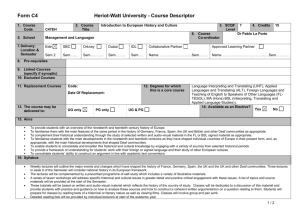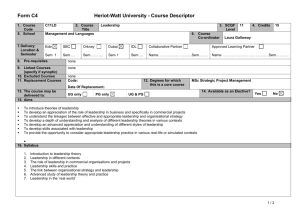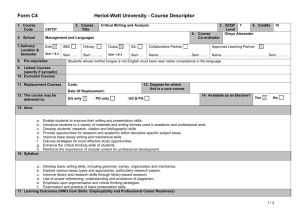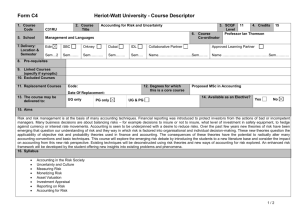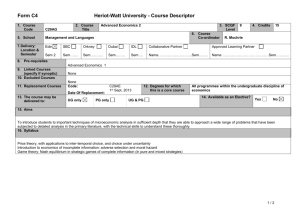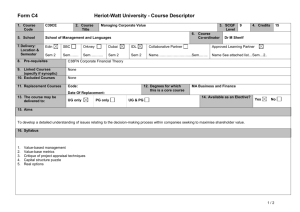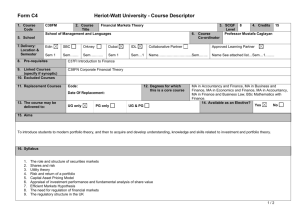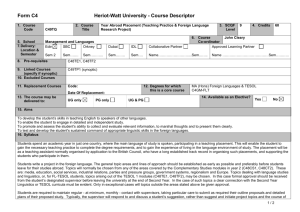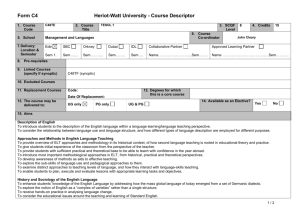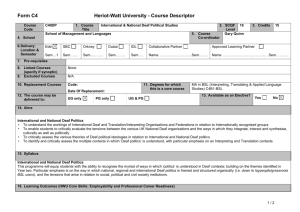C41IS_C4 - Heriot
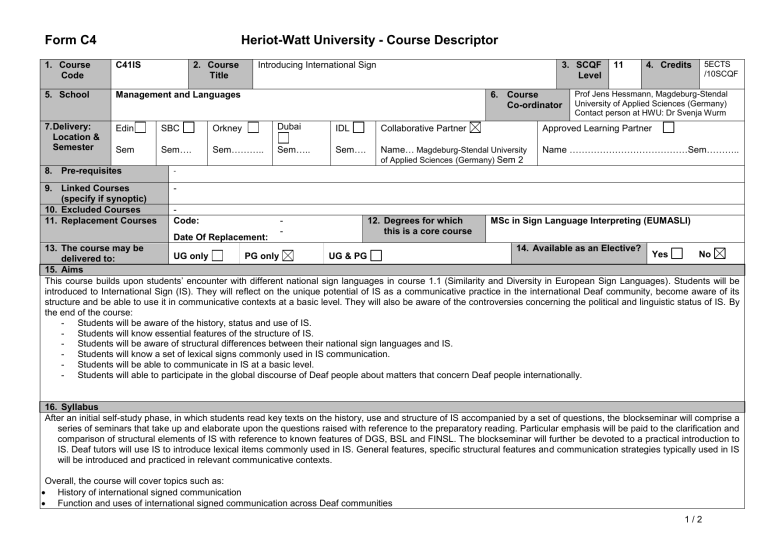
Form C4
1. Course
Code
5. School
7. Delivery:
Location &
Semester
Heriot-Watt University - Course Descriptor
C41IS
Management and Languages
Edin
Sem
SBC
Sem….
2. Course
Title
Introducing International Sign
Orkney
Sem………..
Dubai
Sem …..
IDL
Sem….
6. Course
Co-ordinator
3. SCQF
Level
11 4. Credits 5ECTS
/10SCQF
Prof Jens Hessmann, Magdeburg-Stendal
University of Applied Sciences (Germany)
Contact person at HWU: Dr Svenja Wurm
Collaborative Partner
Name…
Magdeburg-Stendal University of Applied Sciences (Germany) Sem 2
Approved Learning Partner
Name …………………………………Sem………..
8. Pre-requisites -
9. Linked Courses
(specify if synoptic)
-
10. Excluded Courses
11. Replacement Courses
13. The course may be delivered to:
-
Code:
Date Of Replacement:
UG only PG only
-
-
UG & PG
12. Degrees for which this is a core course
MSc in Sign Language Interpreting (EUMASLI)
14. Available as an Elective?
Yes No
15. Aims
This course builds upon students’ encounter with different national sign languages in course 1.1 (Similarity and Diversity in European Sign Languages). Students will be introduced to International Sign (IS). They will reflect on the unique potential of IS as a communicative practice in the international Deaf community, become aware of its structure and be able to use it in communicative contexts at a basic level. They will also be aware of the controversies concerning the political and linguistic status of IS. By the end of the course:
- Students will be aware of the history, status and use of IS.
- Students will know essential features of the structure of IS.
- Students will be aware of structural differences between their national sign languages and IS.
- Students will know a set of lexical signs commonly used in IS communication.
- Students will be able to communicate in IS at a basic level.
- Students will able to participate in the global discourse of Deaf people about matters that concern Deaf people internationally.
16. Syllabus
After an initial self-study phase, in which students read key texts on the history, use and structure of IS accompanied by a set of questions, the blockseminar will comprise a series of seminars that take up and elaborate upon the questions raised with reference to the preparatory reading. Particular emphasis will be paid to the clarification and comparison of structural elements of IS with reference to known features of DGS, BSL and FINSL. The blockseminar will further be devoted to a practical introduction to
IS. Deaf tutors will use IS to introduce lexical items commonly used in IS. General features, specific structural features and communication strategies typically used in IS will be introduced and practiced in relevant communicative contexts.
Overall, the course will cover topics such as:
History of international signed communication
Function and uses of international signed communication across Deaf communities
1 / 2
Form C4 Heriot-Watt University - Course Descriptor
Status of IS in relation to other contact languages (Pidgins, Creoles)
Structure of IS
Comparison between grammatical features of national sign languages and IS
Introduction of lexical items commonly used in IS
Practicing structural features and communication strategies in IS
17. Learning Outcomes (HWU Core Skills: Employability and Professional Career Readiness)
Subject Mastery
Personal Abilities
A critical understanding of the principal theories, principles and concepts relating to International Sign.
A critical awareness of current issues relating to the use and attitude towards International Sign.
Knowledge that covers the features, terminology and conventions relating to the use and attitude towards International Sign.
Use a significant range of the principal techniques relating to the use of International Sign.
Extend skills in signed communication in international contexts.
18. Assessment Methods
Critically review knowledge and thinking in linguistic theories relating to the area of IS.
Apply critical analysis, evaluation and synthesis to selected linguistic theories relating to the area of IS which are at the forefront of the discipline.
Use basic communication with peers and more senior colleagues using IS.
Use a wide range of software to support and enhance work at this level.
Take responsibility for own work and progress in using IS.
19. Re-assessment Methods
Coursework & Continuous assessment
Method Duration of Exam
(if applicable)
Weighting (%)
100%
Synoptic courses? Method
Submission of course work
Duration of Exam
(if applicable)
Diet(s)
20. Date and Version
Date of Proposal October 2012 Date of Approval by
School Committee
Date of
Implementation
January 2014 Version
Number
1.0
2 / 2
